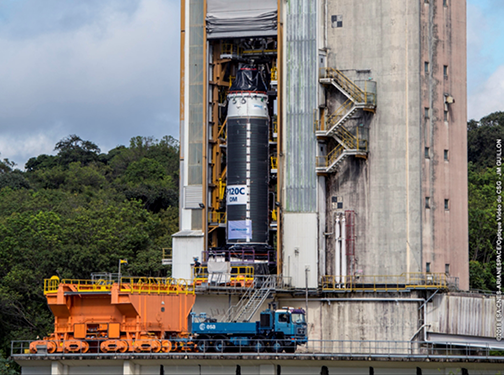
The P120C solid rocket motor for the Ariane 6 and Vega-C was successfully tested on July 16 in Kourou, French Guiana, on the BEAP test bench for solid rocket motors, operated by the French space agency CNES.

Static test firing of ArianeGroup and Avio's P120C rocket engine.
This successful test of the first P120C ever produced is a major step in the development of the future European launchers, Ariane 6 and Vega-C. The P120C, co-developed by ArianeGroup and Avio, on behalf of their 50/50 joint venture Europropulsion, is the world’s largest monolithic carbon fiber SRM. The program for the development of Ariane 6 and Vega-C was decided on at the European Space Agency (ESA) Ministerial Council in 2014. Two further test stand firings will follow to qualify this motor before the first flight of Vega-C in 2019 and that of Ariane 6 in 2020.
With major investments required for producing solid-propellant motors, the P120C is a perfect example of rationalization, as the engine will equip Ariane 6 (in its two-booster Ariane 62 and four-booster Ariane 64 versions) and the first stage of Vega-C. This will allow as many as 35 motors to be produced each year, making optimal use of industrial infrastructures on the European continent and in French Guiana, meeting the goals of the Ariane 6 and Vega-C programs: Optimized costs, shorter cycles owing to a simplified design and the application of innovative technologies and processes.
The P120C consists of two principal parts. The first is the structural casing, built by Avio and made of carbon fiber (filament-wound, automated fabric layup pre-impregnated epoxy sheets). The second part is the nozzle, built by ArianeGroup and made of various composite materials, including carbon/carbon; it allows very high speed ejection of the extremely hot gases (3,000°C) generated by the motor, thus creating thrust by transforming the combustion gas energy into kinetic energy. The latter can also pivot, which enables the launcher to be piloted. Propellant casting and motor final integration are both performed in French Guiana.
The P120C in figures:
· Motor length: 13.5 m
· Diameter: 3.4 m
· Propellant mass: 142 t
· Motor dry mass: 11t
· Motor case mass: 8.3 t
· Average thrust: 4,500 kN
· Maximum thrust: 4,650 kN
· Specific impulse: 278.5 s
· Combustion time: 135 s

